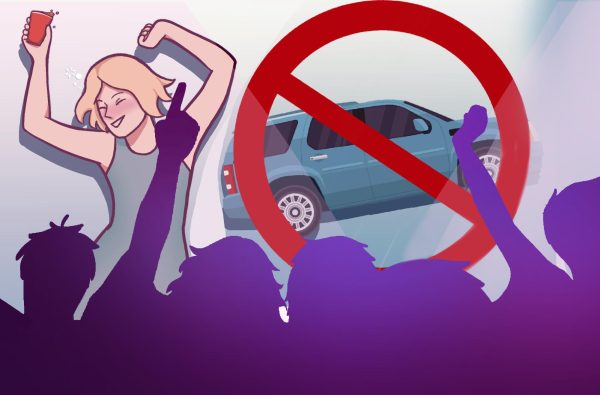Good vibrations, no sensations
August 29, 2014
You can’t crave something you’ve never tasted.
While 75 percent of women cannot reach orgasm from penetrative sex alone, a tiny percentage will never experience the sensation whatsoever.
Anorgasmia, the medical term for those who regularly have difficulty reaching orgasm after sufficient sexual stimulation resulting in psychological distress, affects most women at one point during their lifetime.
This week, I had the privilege of interviewing an anorgasmic woman. For obvious reasons, this woman wished to remain anonymous. In this column, I will refer to her as Libby, short for the Latin term “liberalis,” meaning generous; I do so because regarding sexual endeavors, she is just that.
Libby is a 21-year-old, happily-partnered woman who visited her OB-GYN approximately one year ago to discuss her inability to orgasm after making both partnered and solo attempts over the course of her lifetime. After eliminating the possibility of psychological or relational distress, her doctor explained that she was actually quite normal. Her doctor informed her that many women don’t experience orgasm until their 30s, and some never do at all.
“I don’t really think of it as a problem,” Libby said. “It’s one of those ‘If you haven’t had it, you don’t know what you’re missing’ situations.”
She said she has tried toys and other forms of sexual stimulation and maintains that she could completely go without sex.
“Sex is the physical equivalent of what handholding is for most people for me.” Libby continued, “It really does nothing.”
Although her inability to orgasm and overall disinterest in sex served as a source of anxiety with past partners, her current boyfriend of two years is very understanding and doesn’t pressure her in the bedroom. Don’t be fooled, just because she’s not hungry, doesn’t mean her boyfriend has to fast.
Libby has sex with her boyfriend anywhere from one to three times per week to satisfy his physical needs and strengthen their relational bond.
“If we’re up to three times in one week, I know I’m really on a roll,” she joked.
Libby explained that while there’s nothing physical in it for her, she understands that this is how her boyfriend expresses desire and love. With that, she said she is happy to oblige and even makes efforts to surprise him when she finds the time during the week. Her idea of intimacy: cuddling, provided that it doesn’t interfere with her sleep.
“I’m pretty simple when it comes to intimacy,” she said. “I just love to look at him.”
However, Libby is hopeful. Her doctor explained that a lot of women experience higher levels of sexual satisfaction after vaginal childbirth, which could be the case for her as she plans to have children in the future.
Physicians stress the importance of such hopefulness for women experiencing any sexual dysfunction. Mary Lopes, a nurse practitioner at Pullman Family Medicine with more than 30 years of experience in women’s health, said that medical professionals tend to refer to these women as “preorgasmic versus anorgasmic.”
This distinction is important because it can mean the difference between giving up and continuing to make an effort toward improving sexual satisfaction.
“Orgasm is always possible,” Lopes said. “Therefore, if they can look at it as a project that could be fun to work on, they will see the experience in a more positive light.”
Lopes explained that a small percentage of preorgasmic people have a history of childhood sexual abuse and should seek counseling. However, if that’s not the case she recommends seeing a doctor to rule out any physical barriers to orgasm such as fused labia.
For those wanting to read up on the matter, Lopes recommended Lonnie Barbach’s “For Yourself: The Fulfillment of Female Sexuality.”She said that although the book is older, it takes a very practical approach to female sexuality.
But Libby’s not alone. Approximately 15 percent of women have difficulty reaching orgasm while a reported 10 percent never have, according to an article in Psychology Today.
Anorgasmia can be broken down into four categories: primary, secondary, situational and general.
Primary anorgasmia refers to people who have never had an orgasm, which is everyone at some point in time. Fortunately, this stage ends when a person begins to explore their body and learns what works for them. Secondary anorgasmia describes people who used to have orgasms but now experience difficulty achieving climax.
Situational anorgasmia refers to people who can only orgasm under specific circumstances, such as during oral sex or within the confines of their masturbatory routine. General anorgasmia refers to the poor souls who do not experience orgasm alone or with a partner.
Causes of anorgasmia range far and wide but, like most sexual dysfunctions, are psychological in nature. People under mental duress such as anxiety or depression often experience anorgasmia. Others may be stressed by smaller but equally paralyzing psychological and psychosocial conditions such as performance anxiety, gender stigmas, fear, guilt or embarrassment during sexual acts. Anorgasmia can also occur within a relationship when one or more partners feel disconnected, untrusting or emotionally conflicted against the other person.
Physical barriers to orgasm can include chronic and infectious disease, gynecologic problems, medications, alcohol and drug use, and aging.
For anyone experiencing difficulty orgasming, there is hope. In fact, after searching Google, I’m convinced that more people in the world are sexually frustrated than satisfied. For all of you out there like Libby, I’m praying your day will come, pun totally intended.



















